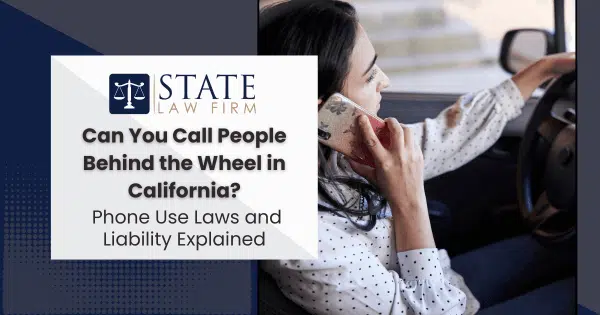Navigating California’s roads safely can feel like walking a legal tightrope—especially when it comes to using your phone behind the wheel. At Bufete de abogados estatal, a boutique personal injury practice in Sherman Oaks run by a team of driven, evolving litigators, we understand that law isn’t just about statutes—it’s about real people, real decisions, and real consequences.
In California, even a quick call can come with legal risks. In fact, the Oficina de Seguridad Vial de California reports that in 2022, 148 people were killed in crashes involving a distracted driver, with mobile phones among the leading causes of distraction (OTS). That’s why this guide is here: to help you understand the state’s hands-free driving laws under California Vehicle Code § 23123.5, know when—or if—you can legally make or accept calls while driving, and appreciate how phone use can affect liability if there’s an accident.
Our goal is to be your go-to resource for clarity on:
- Understanding California’s hands-free driving laws, including the nuances of headset and Bluetooth use.
- When calling while driving is permitted—or not, and how exceptions apply.
- The penalties and legal implications for distracted driving are explained in detail in this California appellate opinion.
- How distracted driving affects liability in accidents, especially under negligence principles in California.
- Best practices for staying connected safely, including tips highlighted in California’s “No-Touch” law.
Whether you’re a cautious parent, a commuter with endless calls, or someone weighing their legal options after a crash, we’ve got your back. And if you—or someone you know—has been injured in a motorcycle crash, remember that riders injured in California should consider working with our Bakersfield motorcycle accident lawyers. You can also schedule a free consultation with our team today. We’re here, listening—safely—when you need us most.
Understanding California’s Hands-Free Driving Laws
California has one of the strictest approaches to distracted driving in the nation. Under the state’s hands-free law, drivers are prohibited from holding a phone in their hands while operating a motor vehicle. This means no texting, no scrolling, and no holding the phone up to your ear during a call.
The intent behind the law is simple: keeping both hands on the wheel and both eyes on the road. Still, drivers can use mobile devices in limited ways:
- Phones may be operated through voice commands or single taps/swipes.
- Devices must be mounted on the dashboard, windshield, or center console in a way that doesn’t block the driver’s view.
- Drivers under the age of 18 face even stricter rules—they cannot use a phone at all while driving, not even hands-free.
The takeaway? If you need to communicate, keep it quick, voice-controlled, and mounted securely.
The Specifics of Calling While Driving: What You Need to Know
So, can you talk on the phone while driving in California? The answer is yes—with limits. You are allowed to make and receive calls, but only if you’re using a hands-free system, such as:
- Bluetooth through your car’s infotainment system
- A wired or wireless headset
- A voice-activated speakerphone
Anything requiring you to hold the device in your hand violates the statute. And the law applies not just to freeways—it includes city streets, stop lights, and even traffic jams.
There are a few exceptions. Emergency personnel may use handheld devices in the course of their duties, and private citizens may legally handle a phone in a true emergency (such as calling 911). But for the average driver, compliance is non-negotiable.
Consequences of Violating Phone Use Laws Behind the Wheel
Violating California’s phone use law carries real consequences. According to the California courts, the fines start small but add up quickly:
- $20 for a first offense
- $50 for subsequent offenses
But that’s just the beginning. With court fees and assessments, the actual cost can be several times higher. And repeat violations can put a point on your driving record—something insurers may seize on to raise your premiums.
As one California appellate decision made clear, the courts will not hesitate to uphold citations for even minimal touches of a phone. Simply holding or tapping a device while driving may be enough to trigger liability.
Consejo profesional: Treat your phone like your seatbelt—non-negotiable. If it’s not mounted and hands-free, don’t touch it.
The Impact of Distracted Driving on Liability in Accidents
The real risk isn’t just the ticket—it’s the liability exposure if a crash occurs. Under California negligence law, a driver who causes an accident while using their phone can be found negligent per se, meaning the violation of the law itself may establish fault.
That means if you were holding your phone and rear-ended someone, proving fault could become almost automatic. Insurance companies know this and may use distracted driving as leverage to deny or reduce claims.
Worse still, if someone is seriously injured because another driver was distracted, the financial fallout can extend to medical bills, lost wages, and even wrongful death claims.
This is why our team at State Law Firm encourages anyone injured in a distracted driving crash to speak with an attorney as early as possible. A skilled lawyer can preserve evidence, navigate insurance negotiations, and pursue the compensation you deserve.
Best Practices for Safe Phone Use While Driving in California
The safest option is to avoid using your phone while driving altogether. But for many Californians—especially commuters and working professionals—some level of communication is unavoidable. Here are some best practices to reduce risk:
- Set up “Do Not Disturb While Driving.” Most smartphones now include this feature, silencing notifications until you arrive.
- Use voice assistants. Siri, Google Assistant, and Alexa can place calls, send texts, or start navigation without a tap.
- Plan ahead. Enter your destination before pulling out of the driveway.
- Pull over safely. If you must handle your device manually, stop at a safe location first.
- Try apps designed for safer driving. Tools like Android Auto or Apple CarPlay make compliance easier and safer.
As West Coast Trial Lawyers notes, California’s “No-Touch” law doesn’t just discourage risky behavior—it codifies the safest practices into enforceable rules.
Prioritize Safety and Stay Informed About Phone Use Laws While Driving in California
Phone use laws in California aren’t just red tape; they’re designed to save lives. From the legal framework in Vehicle Code § 23123.5 to the mounting evidence on distracted driving crashes, the message is clear: safer driving begins with more intelligent choices.
At State Law Firm, we see firsthand how one moment of distraction can change lives forever. That’s why we’re committed to helping victims of distracted driving hold negligent parties accountable. If you’ve been affected by a crash caused by phone use behind the wheel, schedule a free consultation today. And if you’re a rider injured in California, know that our Bakersfield motorcycle accident lawyers are ready to help you navigate your next steps with skill and care.
Stay safe, stay informed, and when in doubt—keep your hands on the wheel and your phone out of reach.


